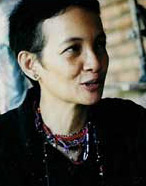 |
||
|---|---|---|
| CP Foundation | About CP Biennale | 2003 | 2005 | Contact Us | >||
           
|
||
|
All these stories eventually find their way to her works, without Yani's realizing it herself. This cultural influence is also found in her choice of medium - she rarely makes wooden sculptures because she thinks that the remains of the wood she does not use for her work will merely become a waste. The nature and the traditional wisdom often add vivid colors to her works. Yani's sculptures offer meditations on life and on everyday experience, complete with the poems and the creative concepts that she embeds in her works. Visually, her sculptures usually resemble chunks of soil, the walls of a cave, or the root of a tree. Aside from that, movements - and of course space - also become her main attention. Yani's sculptures, even since the beginning of her career, always depict something that moves, something that grows. This is not only found in the movements of the body, the hands, or the head, but also in the swinging of the shawl or any other object attached to the figure. So far, Yani continues to explore and work on this tendency. Some observers say that Yani's installation works are the continuation and the sure evolvement of her sculptures: They tell of the movements and the posture of nature. In Endless (2002), for example, she not only insinuates the cycle of nature strength and fragility, but she also presents hanging objects that appear to be floating in the air. The intricate installation work displays these scattered objects in an orderly disorder. The work displayed in this open biennale still offers similar nuances: Floating objects, hanging above a "well" that serves as the base. The installation depicts Yani's efforts for a self-reflection against her past - a difficult effort that nevertheless must be done. Maman Gantra Born on August 17, 1955 in Rangkasbitung, West Java. SELECTED SOLO EXHIBITIONS SELECTED GROUP EXHIBITIONS |
||
|
CP Foundation | About CP Biennale | 2003 | 2005 | Contact Us
Jl. Suryopranoto 67A, Jakarta 10160, Indonesia. ph. +62.21.3448126, 3853206 | fax. +62.21.3853203, 3853208 info@cp-foundation.org |
||
 Yani M. Sastranegara was grew up in a plantation in East Sumatra. It is no wonder, then, when she becomes dearly attached to nature. Her father, a military man-cum-plantation employee, often took her in his journeys to the woods, the caves, and the rivers near the plantation where they lived. Her maternal grandmother, meanwhile, provided Yani with traditional tales and values. "I still remember how my late grandmother, in her kain-kabaya, climbed the stairs to the rice barn. I also remember the words she used to say before she took the rice out or when she put the rice into the barn," says Yani.
Yani M. Sastranegara was grew up in a plantation in East Sumatra. It is no wonder, then, when she becomes dearly attached to nature. Her father, a military man-cum-plantation employee, often took her in his journeys to the woods, the caves, and the rivers near the plantation where they lived. Her maternal grandmother, meanwhile, provided Yani with traditional tales and values. "I still remember how my late grandmother, in her kain-kabaya, climbed the stairs to the rice barn. I also remember the words she used to say before she took the rice out or when she put the rice into the barn," says Yani.